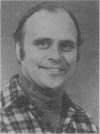Abstract
The purpose of this study was to describe the anthropometric and physiological parameters that apply to a USA amateur rugby union club team. Fifteen players who were members of the club's first team were evaluated for body composition, muscular strength, power and endurance, flexibility, anaerobic power, anaerobic capacity, and cardio-respiratory function shortly after completion of the regular season. Means for some of the variables measured include: age, 29 yr; height, 180 cm; weight, 84 kg; lean body weight, 74 kg; body fat, 12%, endurance sit-ups, 50/min; vertical jump height, 51 cm; anaerobic power output, 132 m.kg.s-1 (1.32 kw); anaerobic capacity, 2247 m.kp/40s (22.5 kJ); maximum heart rate, 186 beats/min; maximum ventilation, 175 l/min-1; maximum respiratory quotient 1.23; and maximum oxygen uptake, 56.6 ml.kg-1 min-1. In comparison with other rugby players studied these players had higher maximum oxygen uptake values, were similar in endurance sit-up and vertical jump ability, exhibited less upper body strength, and the forwards had lower body fat percentages. They were generally within the range of scores found to describe the aerobic and anaerobic fitness, and body composition of other élite amateur and professional intermittent sport athletes.
Full text
PDF







Images in this article
Selected References
These references are in PubMed. This may not be the complete list of references from this article.
- BROZEK J., GRANDE F., ANDERSON J. T., KEYS A. DENSITOMETRIC ANALYSIS OF BODY COMPOSITION: REVISION OF SOME QUANTITATIVE ASSUMPTIONS. Ann N Y Acad Sci. 1963 Sep 26;110:113–140. doi: 10.1111/j.1749-6632.1963.tb17079.x. [DOI] [PubMed] [Google Scholar]
- Bell W. Body composition of rugby union football players. Br J Sports Med. 1979 Apr;13(1):19–23. doi: 10.1136/bjsm.13.1.19. [DOI] [PMC free article] [PubMed] [Google Scholar]
- Bell W. Distribution of skinfolds and differences in body proportions in young adult rugby players. J Sports Med Phys Fitness. 1973 Jun;13(2):69–73. [PubMed] [Google Scholar]
- Jackson A. S., Pollock M. L. Generalized equations for predicting body density of men. Br J Nutr. 1978 Nov;40(3):497–504. doi: 10.1079/bjn19780152. [DOI] [PubMed] [Google Scholar]
- Katch V., Weltman A., Martin R., Gray L. Optimal test characteristics for maximal anaerobic work on the bicycle ergometer. Res Q. 1977 May;48(2):319–327. [PubMed] [Google Scholar]
- McDonough J. R., Kusumi F., Bruce R. A. Variations in maximal oxygen intake with physical activity in middle-aged men. Circulation. 1970 May;41(5):743–751. doi: 10.1161/01.cir.41.5.743. [DOI] [PubMed] [Google Scholar]
- Raven P. B., Gettman L. R., Pollock M. L., Cooper K. H. A physiological evaluation of professional soccer players. Br J Sports Med. 1976 Dec;10(4):209–216. doi: 10.1136/bjsm.10.4.209. [DOI] [PMC free article] [PubMed] [Google Scholar]
- Rusko H., Havu M., Karvinen E. Aerobic performance capacity in athletes. Eur J Appl Physiol Occup Physiol. 1978 Mar 20;38(2):151–159. doi: 10.1007/BF00421531. [DOI] [PubMed] [Google Scholar]
- Wilmore J. H. The application of science to sport: physiological profiles of male and female athletes. Can J Appl Sport Sci. 1979 Jun;4(2):103–115. [PubMed] [Google Scholar]




